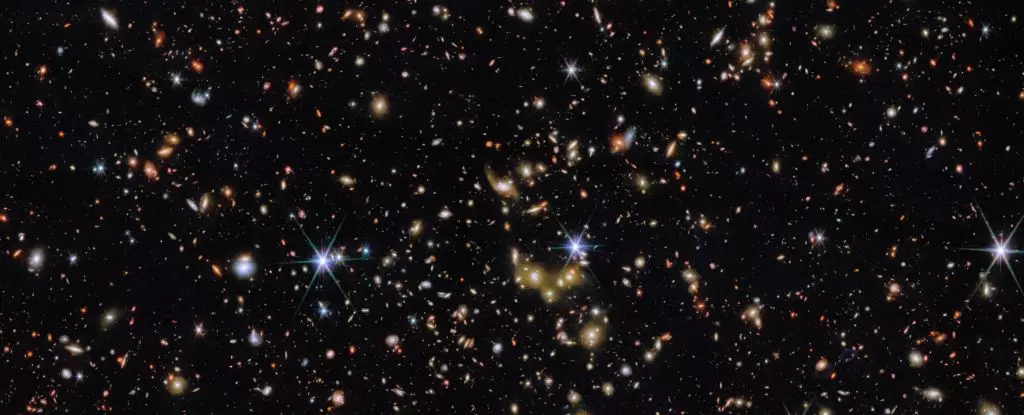In the age of uncharted space exploration, a deep field image from the James Webb Space Telescope (JWST) offers profound insights into the universe’s vastness. This powerful telescope recently captured an astonishing view of a minuscule region of the sky that appears deceptively familiar. To the untrained eye, it might resemble what we see on a clear night: a sprinkle of stars twinkling amidst the darkness. However, a closer examination reveals the breathtaking truth—what is displayed is not merely a scattering of points of light, but rather an expansive panorama of galaxies spanning nearly 12 billion light-years into the universe’s past.
The details embedded in the JWST image serve not just as a magnificent visual display, but as a stark reminder of our cosmic insignificance. Within this minuscule patch of sky—less than one-fifth the width of the full Moon—exists an intricate tapestry of galaxies that paint the historical record of cosmic evolution. This is a powerful sentiment, one that should instill both humility and wonder in anyone witnessing the grandeur of the universe.
Observational Marvels of JWST
Unique among the stars, the images produced by the JWST are marked by distinctive pointy diffraction spikes, a feature arising from the telescope’s construction. This specific optical trait helps differentiate foreground stars from the myriad galaxies that lie in the background. Stars, with their concentrated light, exhibit these spikes while the more diffuse light from galaxies does not. This subtle distinction is not merely a matter of aesthetic detail but one of astronomical significance, allowing scientists and enthusiasts alike to navigate through the complex relationships between celestial objects.
The fascinating aspect of this image lies in its focal point—a group of galaxies glowing with a golden hue, revealing information that stretches back approximately 6.5 billion years. This temporal journey is nearly half of the universe’s estimated age of 13.8 billion years. The data forms a cornerstone for ongoing astronomical research, like the COSMOS-Web survey, designed to map the distribution and evolution of galaxies throughout the universe.
Interconnectedness of Cosmic Structures
In order to fully grasp the importance of these observations, we must consider the larger picture: the universe is not a random spattering of galaxies, but rather an organized network of cosmic structures intricately linked through dark matter and hydrogen—the so-called cosmic web. This vast web serves as a framework within which galaxies gather, revealing an underlying order worthy of exploration and understanding. The JWST’s capacity to scrutinize these complexities is monumental, providing new lenses through which to view the nature of the cosmos.
Discoveries from combining JWST observations with data from the Chandra X-ray Observatory highlight the enormous size of this galaxy group, making it the most massive identified in this particular field of view. The hot gas enveloping these galaxies emits powerful X-radiation that can be detected by Chandra, further emphasizing the interplay between different forms of cosmic matter and energy.
Unveiling the Multitude of Galaxies
For astronomers, the JWST captures more than just a breathtaking array of lights. In an exhaustive catalog created by an international team led by Greta Toni from the University of Bologna, they identified a staggering 1,678 groups of galaxies within this tiny patch of sky. These aren’t isolated galaxies but clusters of galaxies interacting within their gravitational pull, uniting to become larger cosmic entities. The implications are extraordinary; it suggests that every similar fragment of the night sky could host thousands of galaxies waiting to be discovered, unveiling a universe far richer and more complex than previously understood.
The fact that such an abundance of galaxies resides in a mere 6.44 by 6.44 arcminute area—a fraction of the size of the full Moon—forces us to confront the immensity of the cosmos. Each tiny patch of our celestial dome holds the potential for an entire universe of connections and histories, waiting to be revealed. If we peer into the night sky with this realization in mind, how might our understanding of our place in the universe shift?
Space, once thought to be an empty void, proves to be teeming with life—an intricate web of galaxies, each with its own story to tell, illuminating the dark expanses of the cosmos. As JWST’s imaging prowess continues to astonish and inspire, it implores us not only to gaze, but also to reflect. What other secrets might these distant lights within the cosmic tapestry reveal?


Leave a Reply